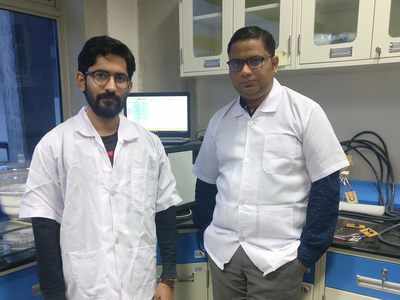- News
- Education News
- News
- IIT-H develops materials to detect hydrogen gas leakage
Trending
This story is from September 5, 2019
IIT-H develops materials to detect hydrogen gas leakage
Detecting hydrogen gas leaks, which can result in hazardous industrial accidents, has been made easier by researchers from the Indian Institute of Technology (Hyderabad and Jodhpur) who developed materials that can detect such leaks with high sensitivity.

Dr. Chandra Shekhar Sharma (R), Associate Professor, Dept of Chemical Engineering, IIT Hyderabad & Mr. Akash Nathani, Research Scholar, IIT-H.
HYDERABAD: Detecting hydrogen gas leaks, which can result in hazardous industrial accidents, has been made easier by researchers from the Indian Institute of Technology (Hyderabad and Jodhpur) who developed materials that can detect such leaks with high sensitivity.
The materials developed by team of researchers from the two institutes can help them develop a reliable and robust hydrogen gas sensor that can be utilised for domestic as well as industrial applications.Considering that the gas is difficult to produce, hard to detect and is inflammable, researchers viewed its leakage to be hazardous. Since hydrogen has no colour or odour, researchers felt it was imperative to develop tools and sensors that can detect its leakage.
"We exposed zinc oxide in combination with carbon fibre nanostructures to hydrogen gas. Once exposed, resistance of zinc oxide reduced resulting in following of current. Change in current patterns indicated presence of hydrogen," said Akash Nathani, research scholar from IIT-H who worked on the research. "Exposure to hydrogen also improved performance of carbon fibre nanostructures indicating higher sensitivity of hydrogen with the material," said Nathani.
Currently, many kinds of hydrogen sensors are being studied, including optical, electrochemical and electrical sensors. While most of them available for industrial application are expensive, materials developed by IIT researchers are affordable and portable.
The materials developed by team of researchers from the two institutes can help them develop a reliable and robust hydrogen gas sensor that can be utilised for domestic as well as industrial applications.Considering that the gas is difficult to produce, hard to detect and is inflammable, researchers viewed its leakage to be hazardous. Since hydrogen has no colour or odour, researchers felt it was imperative to develop tools and sensors that can detect its leakage.
"We exposed zinc oxide in combination with carbon fibre nanostructures to hydrogen gas. Once exposed, resistance of zinc oxide reduced resulting in following of current. Change in current patterns indicated presence of hydrogen," said Akash Nathani, research scholar from IIT-H who worked on the research. "Exposure to hydrogen also improved performance of carbon fibre nanostructures indicating higher sensitivity of hydrogen with the material," said Nathani.
Currently, many kinds of hydrogen sensors are being studied, including optical, electrochemical and electrical sensors. While most of them available for industrial application are expensive, materials developed by IIT researchers are affordable and portable.
The collaborative research was published recently in peer-reviewed journal Sensors and Actuators. The paper was co-authored by Chandra Shekhar Sharma and Mahesh Kumar and research scholars - Vijendra Singh Bhati, Akash Nathani and Adarsh Nigam.
End of Article
FOLLOW US ON SOCIAL MEDIA










